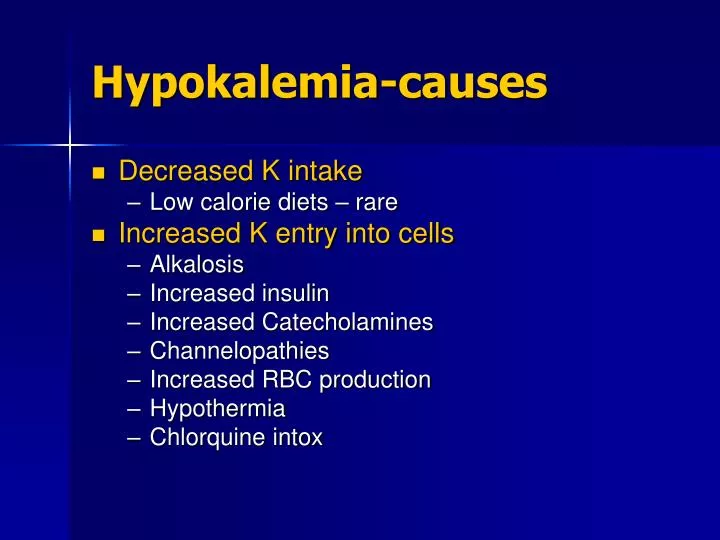Details of hypokalemic and thyrotoxic periodic paralysis and hypokalemic hypertensive as well as normotensive disorders are also provided. (1) the definition and prevalence of hypokalemia, (2) the physiology of potassium homeostasis, (3) the various causes leading to hypokalemia, (4) the diagnostic steps for the assessment of hypokalemia and (5) the appropriate treatment of hypokalemia depending on the cause. The aim of this review is to present updated information regarding: View hypokalemia.pdf from nsg 3023 at south university, savannah. The most common cause is excess loss from the kidneys or gastrointestinal tract.
Severe features of hypokalemia that require urgent treatment include a serum potassium. Details of hypokalemic and thyrotoxic periodic paralysis and hypokalemic hypertensive as well as normotensive disorders are also provided. The most common cause is excess loss from the kidneys or gastrointestinal tract. (1) the definition and prevalence of hypokalemia, (2) the physiology of potassium homeostasis, (3) the various causes leading to hypokalemia, (4) the diagnostic steps for the assessment of hypokalemia and (5) the appropriate treatment of hypokalemia depending on the cause. View hypokalemia.pdf from nsg 3023 at south university, savannah.
The aim of this review is to present updated information regarding: Serum potassium levels less than 2.5 mmol/l are classified as severe. Hypokalemia is caused by decreased intake, renal losses, gastrointestinal losses, or transcellular shifts. The condition can result from many different medical problems, including those affecting the kidney or gastrointestinal tract. (1) the definition and prevalence of hypokalemia, (2) the physiology of potassium homeostasis, (3) the various causes leading to hypokalemia, (4) the diagnostic steps for the assessment of hypokalemia and (5) the appropriate treatment of hypokalemia depending on the cause.
Serum potassium levels less than 2.5 mmol/l are classified as severe. Increased loss of potassium from the body or movement of potassium into the cells resulting in a blood potassium less than 3 meq/l. View hypokalemia.pdf from nsg 3023 at south university, savannah. Hypokalemia is serum potassium concentration < 3.5 meq/l (< 3.5 mmol/l) caused by a deficit in total body potassium stores or abnormal movement of potassium into cells. On studocu you find all the lecture notes, summaries and study guides you need to pass your exams with better grades. System disorder nicole brown student name _ fluid volume deficits disorder/disease process _ review module. Symptoms of hypokalemia vary depending on the severity and underlying cause but may include muscle weakness, fatigue, cramping, palpitations, and constipation. The most common cause is excess loss from the kidneys or gastrointestinal tract. Inverted/flat t wave, st depression, elevated u wave. The aim of this review is to present updated information regarding: The condition can result from many different medical problems, including those affecting the kidney or gastrointestinal tract. Severe features of hypokalemia that require urgent treatment include a serum potassium. Symptoms of hypokalemia include muscle cramps, weakness, fatigue, and more. A serum potassium level of 2.5 to 3 mmol/l is classified as moderate. Blood potassium less than 3.
Inverted/Flat T Wave, St Depression, Elevated U Wave.
Blood potassium less than 3. Hypokalemia is serum potassium concentration < 3.5 meq/l (< 3.5 mmol/l) caused by a deficit in total body potassium stores or abnormal movement of potassium into cells. The condition can result from many different medical problems, including those affecting the kidney or gastrointestinal tract. A serum potassium level of 2.5 to 3 mmol/l is classified as moderate.
Hypokalemia Is Caused By Decreased Intake, Renal Losses, Gastrointestinal Losses, Or Transcellular Shifts.
View hypokalemia.pdf from nsg 3023 at south university, savannah. On studocu you find all the lecture notes, summaries and study guides you need to pass your exams with better grades. (1) the definition and prevalence of hypokalemia, (2) the physiology of potassium homeostasis, (3) the various causes leading to hypokalemia, (4) the diagnostic steps for the assessment of hypokalemia and (5) the appropriate treatment of hypokalemia depending on the cause. Increased loss of potassium from the body or movement of potassium into the cells resulting in a blood potassium less than 3 meq/l.
System Disorder Nicole Brown Student Name _ Fluid Volume Deficits Disorder/Disease Process _ Review Module.
Symptoms of hypokalemia include muscle cramps, weakness, fatigue, and more. Symptoms of hypokalemia vary depending on the severity and underlying cause but may include muscle weakness, fatigue, cramping, palpitations, and constipation. The most common cause is excess loss from the kidneys or gastrointestinal tract. This chapter provides causes, evaluation, clinical manifestations, and treatment of hypokalemia explicitly.
Serum Potassium Levels Less Than 2.5 Mmol/L Are Classified As Severe.
The aim of this review is to present updated information regarding: Details of hypokalemic and thyrotoxic periodic paralysis and hypokalemic hypertensive as well as normotensive disorders are also provided. Severe features of hypokalemia that require urgent treatment include a serum potassium.









